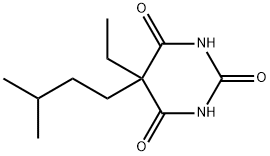
Амобарбитал
- английское имяAmobarbital
- CAS №57-43-2
- CBNumberCB0741976
- ФормулаC11H18N2O3
- мольный вес226.27
- EINECS200-330-7
- номер MDLMFCD00057558
- файл Mol57-43-2.mol
| Температура плавления | 156-158°C |
| Температура кипения | 367.89°C (rough estimate) |
| плотность | 1.1376 (rough estimate) |
| показатель преломления | 1.4620 (estimate) |
| Fp | 9℃ |
| температура хранения | -20°C |
| пка | 8.0(at 25℃) |
| цвет | bitter crystals or leaflets from water |
| Биологические источники | human blood |
| Растворимость в воде | <0.1 g/100 mL at 18.5 ºC |
| Стабильность | Stable. Incompatible with strong oxidizing agents. Hygroscopic. |
| Справочник по базе данных CAS | 57-43-2(CAS DataBase Reference) |
| Рейтинг продуктов питания EWG | 1 |
| FDA UNII | GWH6IJ239E |
| Код УВД | N05CA02 |
| Справочник по химии NIST | Barbituric acid, 5-ethyl-5-isoamyl-(57-43-2) |
| Система регистрации веществ EPA | Amobarbital (57-43-2) |
| UNSPSC Code | 41116107 |
| NACRES | NA.24 |
| Коды опасности | F,T | |||||||||
| Заявления о рисках | 11-23/24/25-39/23/24/25 | |||||||||
| Заявления о безопасности | 16-36/37-45 | |||||||||
| РИДАДР | 3249 | |||||||||
| WGK Германия | 1 | |||||||||
| Класс опасности | 6.1(b) | |||||||||
| Группа упаковки | III | |||||||||
| кода HS | 2933530000 | |||||||||
| Банк данных об опасных веществах | 57-43-2(Hazardous Substances Data) | |||||||||
| Токсичность | LD50 in mice (mg/kg): 212 s.c. (Irrgang) | |||||||||
| DEA Controlled Substances | CSCN: 2126 CSA SCH: Schedule III NARC: No | |||||||||
| NFPA 704: |
|
рисовальное письмо(GHS)
-
рисовальное письмо(GHS)


-
сигнальный язык
опасность
-
вредная бумага
H301:Токсично при проглатывании.
H336:Может вызывать сонливость или головокружение.
H361d:Предполагается, что данное вещество может отрицательно повлиять на неродившегося ребенка.
H412:Вредно для водных организмов с долгосрочными последствиями.
-
оператор предупредительных мер
P202:Перед использованием ознакомиться с инструкциями по технике безопасности.
P261:Избегать вдыхания пыли/ дыма/ газа/ тумана/ паров/ аэрозолей.
P264:После работы тщательно вымыть кожу.
P270:При использовании продукции не курить, не пить, не принимать пищу.
P273:Избегать попадания в окружающую среду.
P301+P310:ПРИ ПРОГЛАТЫВАНИИ: Немедленно обратиться за медицинской помощью. Прополоскать рот.
Амобарбитал химические свойства, назначение, производство
Химические свойства
Crystalline SolidИспользование
Amobarbital for binding at complex I to inhibit mitochondrial electron transport. Amobarbital is regulated as a schedule II compound in the United States and intended only for forensic and research purposes. This product is a qualified Reference Material (RM) that has been manufactured and tested to meet ISO17025 and Guide 34 guidelines. These materials are tested using validated analytical methods on qualified instrumentation to ensure traceability of measurements. All traceable RMs may be distinguished by their CofAs and can be downloaded below using the batch number located on the product label. For a representative CofA please contact our technical support.Определение
ChEBI: A member of the class of barbiturates that is pyrimidine-2,4,6(1H,3H,5H)-trione substituted by a 3-methylbutyl and an ethyl group at position 5. Amobarbital has been shown to exhibit sedative and hy notic properties.Всемирная организация здравоохранения(ВОЗ)
Amobarbital is an intermediate-acting barbiturate which is controlled under Schedule III of the 1971 Convention on Psychotropic Substances. See WHO comment for barbiturates. (Reference: (UNCPS3) United Nations Convention on Psychotropic Substances (III), , , 1971)Общее описание
White crystalline solid with no odor and a slightly bitter taste.Реакции воздуха и воды
Amobarbital is hygroscopic . Insoluble in water.Профиль реактивности
Amines are chemical bases. They neutralize acids to form salts plus water. These acid-base reactions are exothermic. The amount of heat that is evolved per mole of amine in a neutralization is largely independent of the strength of the amine as a base. Amines may be incompatible with isocyanates, halogenated organics, peroxides, phenols (acidic), epoxides, anhydrides, and acid halides. Flammable gaseous hydrogen is generated by amines in combination with strong reducing agents, such as hydrides.Опасность
May be a habit forming drug of abuse.Пожароопасность
Flash point data for Amobarbital are not available, however, Amobarbital is probably combustible.Профиль безопасности
A poison by ingestion,intravenous, intraperitoneal, and subcutaneous routes. Seealso BARBITURATES. When heated to decomposition itemits toxic fumes of NOx.